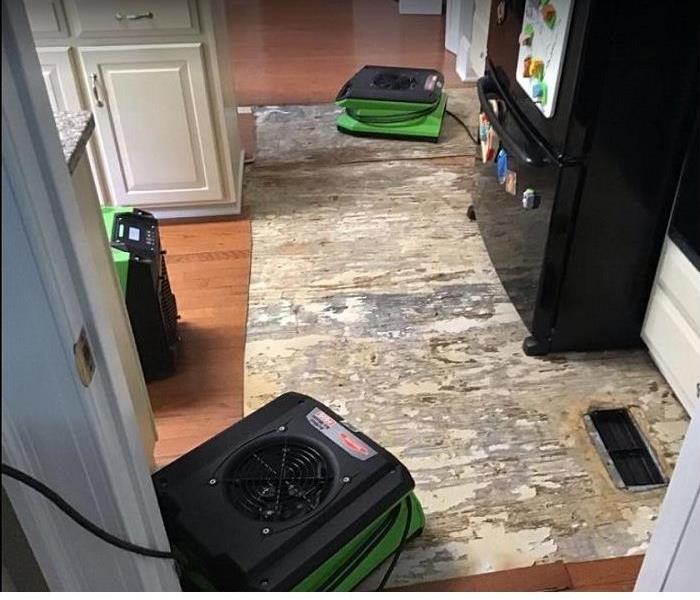Is It True It Can Take Up To a Month To Dry My Evans Flooded Home?
5/8/2020 (Permalink)
Bring in SERVPRO to Remove the Water and Quickly Dry Your Evans Home
Flash floods are a threat throughout the year in this part of the State. There are steps that homeowners can take to minimize the potential for flood loss, so there is no way to 100% avoid it. The best action to take is to bring in a professional restoration services company if it does happen. DIY efforts to dry your property can lead to exposure to harmful elements in the floodwater as well as secondary issues such as mold or ruination of building materials due to the lack of complete water extraction and fast drying. Plus, it can take weeks to dry your Evans home using regular household fans.
What Should I Do to Get Fast Flooding Removal Done in My Home?
Even though grade around the property gets directed away from the house, the gutters inspected are in good working order. The seals around doors and windows are intact, and Evans's home with flooding needs removal using professional equipment. Consumer-grade wet/dry vacuums and standard box fans can not cut it.
No Standing Water? Your Home Probably Still Needs Extraction
When floodwater enters a home, even half an inch of water can do a considerable amount of damage. The migration path of the water can lead under floors, behind walls and under appliances and other furniture. It is impossible to track the migration path visually, and SERVPRO technicians rely on a diverse array of moisture detection equipment to get the job done, such as:
- Thermal imaging
- Moisture sensors
- Infrared cameras
- Flir imaging
What Typically Needs Removal After Contact with Floodwater?
One of the deciding factors for whether or not an item has the potential for restoration gets primarily based on whether or not it is porous. The majority of porous items in a home do not have the potential to get returned to a sanitary standard for reuse.
- Sheetrock wicks the moisture rapidly and begins to deteriorate. Fortunately, in most cases, only a portion of the building materials requires removal to dry the framework of the home. This removal makes the repairs afterward as simple as fitting in a replacement piece of sheetrock and sanding down before priming and painting to match.
- The flooring of many types in local properties is often the biggest loser when it comes to flood damage. Carpeting almost categorically across the board requires removal and disposal as a biohazard after extraction of the water to make it lighter and safer to handle.
- Hardwood flooring may not be a loss if cleanup efforts begin quickly enough after the first water event in the home. The boards may warp and cup, but often can get returned to their original shape through the use of drying applications such as drying mats. Sometimes the boards need to get slightly sanded and refinished for a full restoration.
- Glue-down carpet and tile usually lose their adhesion to the substrate after prolonged exposure to water. In some cases, depending on the construction materials, tiles may get cleaned and disinfected for reuse.
Handling Home Contents Affected by Flood Loss
It can be frustrating to see that a mere inch of floodwater that entered an Evans home can cost a homeowner a favorite sofa. However, once the water gets absorbed into the interior of upholstered furnishings, it rarely has restoration possibilities.
Hardwood furniture can get cleaned using different techniques such as immersion cleaning and agents specifically designed for use on wood. One of the downsides of wood furnishings with exposure to water is when joints crack from the wood's swelling. In those scenarios, the piece may be a loss.
As items get removed from the loss area, SERVPRO techs look over items and move them to a staging area for cleaning. They utilize different methods for disinfection, such as immersion cleaning, where the article is fully submerged in a cleaning solution that works to remove bacteria. The result is a sanitized item ready for reuse in the home.
Final Steps in Flood Loss Mitigation
After drying the property, SERVPRO techs verify that drying goals got attained and then do a final wipe down over the loss area. At this time, any odor control methods needed gets deployed to ready the property for any needed repairs.
SERVPRO of Columbia County at (706) 868-5441 handles any size flooding removal needs your home might have. Contact our certified technicians 24/7 to return your home to its preloss condition.






 24/7 Emergency Service
24/7 Emergency Service
